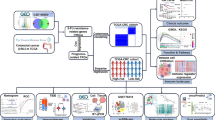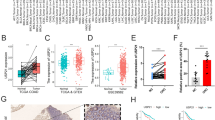Abstract
Background
Colorectal cancer (CRC) remains the third most common cancer in the world. Approximately in 50 percent of patients, metastatic disease is a major cause of death. Therefore, early diagnosis of CRC is crucial for a successful outcome. For the detection of circulating cancer cells, this study applied a sensitive method that employed specific tumor markers for early detection.
Methods
A total of 80 blood samples from 40 CRC patients and 40 age-matched healthy controls were collected for the study. The circulating mRNA levels of two CRC tumor markers, tumor endothelial marker 8 (TEM-8) and carcinoembryogenic antigen (CEA) were evaluated using an absolute quantitative real-time PCR assay in a Stratagene Mx-3000P real-time PCR system. GAPDH was used as the endogenous control.
Results
TEM-8 and CEA were primarily detected more in the CRC patients rather than in the controls: 22/40 vs 9/40, p=0.009 and 30/40 vs 11/40, p=0.00054, respectively. In the CRC patients, the mRNA level of these markers was significantly higher in comparison to the normal controls (p=0.018 and 0.01). The overall sensitivity of this panel was 65% with a specificity of 75%. Statistical analysis for demographic variants did not reach significant values.
Conclusions
TEM-8 and CEA markers were detected more frequently and in significantly higher levels in the blood samples of patients compared with samples from age-matched healthy controls. The copy number of CEA and TEM-8 mRNA, as detected by a real-time quantitative PCR, appears to be a promising marker for evaluating the risk of tumor spread.

Similar content being viewed by others
References
Pisani P, Parkin DM, Bray F, Erratum FJ (1999) Estimates of the worldwide mortality from 25 cancers in 1990. Int J Cancer 83:18–29
Burt RW, DiSario JA, Cannon-Albright L (1995) Genetics of colon cancer: impact of inheritance on colon cancer risk. Annu Rev Med 46:371–379
Greenlee RT, Hill-Harmon MB, Murray T, Thun M (2001) Cancer statistics, 2001. CA Cancer J Clin 51:15–36
Mousavi SM, Gouya MM, Ramazani R, Davanlou M, Hajsadeghi N, Seddighi Z (2009) Cancer incidence and mortality in Iran. Ann Oncol 20:556–563
Yeh CS, Wang JY, Wu CH, Chong IW, Chung FY, Wang YH et al (2006) Molecular detection of circulating cancer cells in the peripheral blood of patients with colorectal cancer by using membrane array with a multiple mRNA marker panel. Int J Oncol 28:411–420
Xu D, Li XF, Zheng S, Jiang WZ (2006) Quantitative real-time RT-PCR detection for CEA, CK20 and CK19 mRNA in peripheral blood of colorectal cancer patients. J Zhejiang Univ Sci B 7:445–451
Silva JM, Rodriguez R, Garcia JM, Munoz C, Silva J, Dominguez G et al (2002) Detection of epithelial tumour RNA in the plasma of colon cancer patients is associated with advanced stages and circulating tumour cells. Gut 50:530–534
Bustin SA, Mueller R (2006) Real-time reverse transcription PCR and the detection of occult disease in colorectal cancer. Mol Aspects Med 27:192–223
Holland PM, Abramson RD, Watson R, Gelfand DH (1991) Detection of specific polymerase chain reaction product by utilizing the 5′—3′ exonuclease activity of Thermus aquaticus DNA polymerase. Proc Natl Acad Sci USA 88:7276–7280
Gerard CJ, Olsson K, Ramanathan R, Reading C, Hanania EG (1998) Improved quantitation of minimal residual disease in multiple myeloma using real-time polymerase chain reaction and plasmid-DNA complementarity determining region III standards. Cancer Res 58:3957–3964
Schrewe H, Thompson J, Bona M, Hefta LJ, Maruya A, Hassauer M et al (1990) cloning of the complete gene for carcinoembryonic antigen: analysis of its promoter indicates a region conveying cell type-specific expression. Mol Cell Biol 10:2738–2748
Nanda A, St Croix B (2004) Tumor endothelial markers: new targets for cancer therapy. Curr Opin Oncol 16:44–49
Rmali KA, Puntis MC, Jiang WG (2005) TEM-8 and tubule formation in endothelial cells, its potential role of its vW/TM domains. Biochem Biophys Res Commun 334:231–238
Godornes C, Leader BT, Molini BJ, Centurion-Lara A, Lukehart SA (2007) Quantitation of rabbit cytokine mRNA by real-time RT-PCR. Cytokine 38:1–7
Schmittgen TD, Livak KJ (2008) Analyzing real-time PCR data by the comparative (CT) method. Nat Protoc 3:1101–1108
Shen C, Hu L, Xia L, Li Y (2008) Quantitative real-time RT-PCR detection for survivin, CK20 and CEA in peripheral blood of colorectal cancer patients. Jpn J Clin Oncol 38:770–776
Cruz I, Ciudad J, Cruz JJ, Ramos M, Gomez-Alonso A, Adansa JC et al (2005) Evaluation of multiparameter flow cytometry for the detection of breast cancer tumor cells in blood samples. Am J Clin Pathol 123:66–74
Turner RR, Giuliano AE, Hoon DS, Glass EC, Krasne DL (2001) Pathologic examination of sentinel lymph node for breast carcinoma. World J Surg 25:798–805
Ghossein RA, Bhattacharya S, Rosai J (1999) Molecular detection of micrometastases and circulating tumor cells in solid tumors. Clin Cancer Res 5:1950–1960
Zieglschmid V, Hollmann C, Bocher O (2005) Detection of disseminated tumor cells in peripheral blood. Crit Rev Clin Lab Sci 42:155–196
Ohlsson L, Hammarstrom ML, Israelsson A, Naslund L, Oberg A, Lindmark G et al (2006) Biomarker selection for detection of occult tumour cells in lymph nodes of colorectal cancer patients using real-time quantitative RT-PCR. Br J Cancer 95:218–225
Wang JY, Wu CH, Lu CY, Hsieh JS, Wu DC, Huang SY et al (2006) Molecular detection of circulating tumor cells in the peripheral blood of patients with colorectal cancer using RT-PCR: significance of the prediction of postoperative metastasis. World J Surg 30:1007–1013
Lloyd JM, McIver CM, Stephenson SA, Hewett PJ, Rieger N, Hardingham JE (2006) Identification of early-stage colorectal cancer patients at risk of relapse post-resection by immunobead reverse transcription-PCR analysis of peritoneal lavage fluid for malignant cells. Clin Cancer Res 12:417–423
Conzelmann M, Linnemann U, Berger MR (2005) Molecular detection of clinical colorectal cancer metastasis: how should multiple markers be put to use? Int J Colorectal Dis 20:137–146
Abbaszadegan MR, Tavasoli A, Velayati A, Sima HR, Vosooghinia H, Farzadnia M et al (2007) Stool-based DNA testing, a new noninvasive method for colorectal cancer screening, the first report from Iran. World J Gastroenterol 13:1528–1533
Acknowledgments
This study was supported by a grant from the Iran National Science Foundation (#85122/68) at Mashhad University of Medical Sciences. The authors sincerely thank all of their colleagues at the Human Genetics Division of the Avicenna Research Institute who contributed in this study.
Author information
Authors and Affiliations
Corresponding author
Rights and permissions
About this article
Cite this article
Raeisossadati, R., Farshchian, M., Ganji, A. et al. Quantitative analysis of TEM-8 and CEA tumor markers indicating free tumor cells in the peripheral blood of colorectal cancer patients. Int J Colorectal Dis 26, 1265–1270 (2011). https://doi.org/10.1007/s00384-011-1230-8
Accepted:
Published:
Issue Date:
DOI: https://doi.org/10.1007/s00384-011-1230-8




